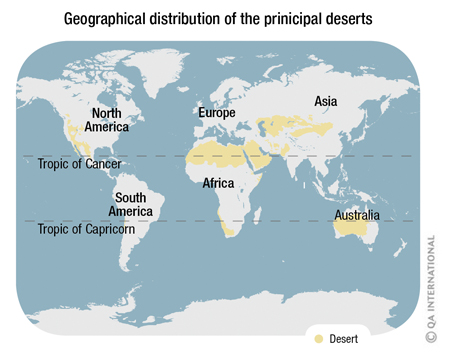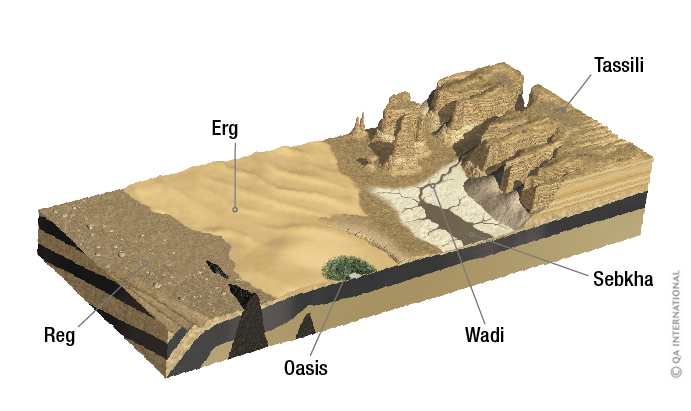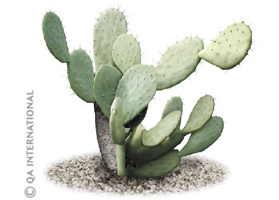
Deserts: where Mother Nature is queen
Deserts are generally situated on both sides of the tropics or in areas that are far away from oceans or separated from them by mountain ranges. These arid regions receive very little precipitation, less than 250 mm per year. Deserts may be hot, like the Sahara (northern Africa), or cold, like the Gobi (Central Asia). The animals and plants that live in the desert cannot be rivaled for their ingenuity in adapting to the wide temperature range and the scarcity of water. Many small animals live in the coolness of a burrow, venturing out only at night. Some are experts at economizing on water and some eat snow, particularly in the cold deserts.

Desert landscape
In the desert, rains are rare. They arrive as raging downpours that suddenly discharge large amounts of water on ground that is dry and almost denuded of vegetation. Temporary rivers form that easily cut through the rocky plateaus and then quickly dry up. Temperatures vary widely from day to night: although very hot during the day, the ground may freeze at night, causing rocks to split apart. In Africa a particular vocabulary is used to describe the desert.

Erg
Ergs are expanses of desert that consist of sand dunes.
Reg
Regs are expanses of desert that consist of stones and pebbles.
Oasis
An oasis is a pocket of vegetation in the middle of the desert linked to emerging groundwater.
Wadi
A wadi is a temporary watercourse in desert regions. Many wadis only flow during a rain, but numerous animals depend on them for their survival.
Sebkha
The water in wadis may form temporary lakes, called sebkhas, which have a salt bed.
Tassili
A tassili is a vast rocky plateau.
Expanting deserts
The deserts are expanding a little more each day. This phenomenon is called desertification. The causes of desertification are many: climatic warming, deforestation, overgrazing, poor farming practices that cause the soil to deteriorate and so on. Every year, more than 50.000 km2 of land suitable for cultivation is turned into desert. The Sahel region of Africa, which stretches from Senegal to the Sudan, south of the Sahara, is particularly affected. The land is drying up and becoming unsuitable for agriculture, the vegetation is disappearing and sandstorms are battering the villages. To counter this phenomenon, members of several local cooperatives have decided to plant fruit trees. These trees will serve as walls to keep out the advancing desert. It is an initiative that will surely bear fruit!
Succulent PLANTS
Succulent plants, like cacti and spurges, are perfectly adapted to the aridity of deserts. They have water reserves stored in their stalk, leaves or roots and they are usually small. Some have leaves reduced to the size of needles, notably to limit water loss through evaporation and to protect themselves from animals. Long roots that spread out just beneath the ground’s surface allow succulent plants to collect every trace of moisture that can be found in a wide area.
Barbary figThe Barbary fig (Opuntia ficus-indica) is a cactus native to Mexico. |
 |
Resin spurgeThe resin spurge (Euphorbia resinifera) is native to Morocco. |
 |
Also see:
In the Visual Dictionary:
- "Earth" section
- "vegetable kingdom" section
- "geology" section
In the encyclopedic capsules:
- The deserts of the Americas and Africa: teeming with life!
- Earth: a rocky planet
- Configuration of the continents
- Islands, treasure chests of biodiversity
- Sunburns, actual burns inflicted to the skin
In the ikonet games:
- Put it in its place!: land pollution




